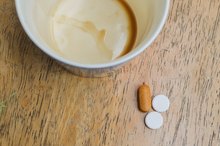Midol is an over-the-counter pain reliever that relieves symptoms directly related to premenstrual syndrome. Midol, which comes in either tablet or caplet form, is typically used by women who are of child-bearing age and are affected by monthly discomfort directly related to PMS. Although Midol does not have to be prescribed by a physician, it is recommended to discuss product usage with your physician.
Types and Active Ingredients
Midol contains a variety of active ingredients. Active ingredients are in addition to the basic ingredients that make up the form of the pill. There are four different types of Midol, and each includes its own active ingredients. Midol Menstrual Complete contains acetaminophen, caffeine and pyrilamine maleate. Midol Extended Relief contains naproxen sodium. Midol Cramps and Body Aches contains ibuprofen. Midol Teen Formula contains acetaminophen and pamabrom.
- Midol contains a variety of active ingredients.
- Midol Extended Relief contains naproxen sodium.
Uses
What Are the Ingredients in Pamprin?
Learn More
All types of Midol are meant to be used before and during a woman’s menstrual cycle. This is the time when the body is preparing for menstruation. During this time the body goes through several mental and physical changes. Midol’s drug combination and variety of products are designed to fit the individual woman based on her specific needs 1. Because each woman’s body is different, she should choose a product type that closely matches her symptoms.
- All types of Midol are meant to be used before and during a woman’s menstrual cycle.
Symptom Reliever
Midol directly works at relieving symptoms related to menstruation and PMS. These symptoms include:
- stomach cramps
- headache
- backache
- fatigue
- bloating
- abdominal pain
Midol contains a diuretic that can help reduce water retention.
Facts about PMS
Midol Alternatives
Learn More
PMS occurs 1 to 2 weeks before the first day of the menstrual period. This time frame is when ovulation occurs. Ovulation stimulates estrogen production, which can trigger fluid retention, a common complaint among many women. Many women also report feeling irritable or grouchy during this time. Midol helps to control some of the symptoms of PMS but does not claim to treat or eliminate PMS or related physical issues.
- PMS occurs 1 to 2 weeks before the first day of the menstrual period.
- Midol helps to control some of the symptoms of PMS but does not claim to treat or eliminate PMS or related physical issues.
Risks
There are some risks associated with taking Midol. Midol contains the diuretic called pamabrom. While a diuretic helps reduce swelling, bloating and inflammation, it can also lead to low potassium levels, which can be dangerous and have an overall harmful effect on the body. Excessive use of the product could cause low potassium levels. Caffeine can also be dangerous if taken regularly in high amounts. Midol contains only around 60mg of caffeine per 2 tablets, but it could cause problems for those sensitive to the effects of caffeine. Those who consume drinks that contain caffeine along with Midol may show symptoms such as rapid or irregular heartbeat, increased anxiety, shaking and sleep disturbances.
- There are some risks associated with taking Midol.
- Midol contains only around 60mg of caffeine per 2 tablets, but it could cause problems for those sensitive to the effects of caffeine.
Related Articles
References
Writer Bio
Julie Boehlke is a seasoned copywriter and content creator based in the Great Lakes state. She is a member of the Society of Professional Journalists. Boehlke has more than 10 years of professional writing experience on topics such as health and wellness, green living, gardening, genealogy, finances, relationships, world travel, golf, outdoors and interior decorating. She has also worked in geriatrics and hospice care.









